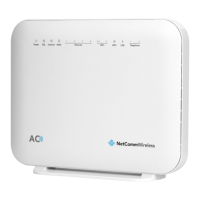VDSL/ADSL2+ Dual Band AC1600 Gigabit Gateway with VoIP
Enter the SIP domain name or IP address of your VoIP Service Provider
here.
Select the checkbox of Use SIP Proxy, if your DSL router uses a SIP proxy.
SIP proxy allows other parties to call DSL router through it. When it is
selected, the following fields appear.
The IP address of the proxy.
The port that this proxy is listening on. By default, the port value is 5060.
Some network service providers require the use of an outbound proxy.
This is an additional proxy, through which all outgoing calls are directed. In
some cases, the outbound proxy is placed alongside the firewall and it is
the only way to let SIP traffic pass from the internal network to the
Internet. When it is selected, the following fields appear.
The IP address of the outbound proxy.
The port that the outbound proxy is listening on. By default, the port value
is 5060.
Select this option if required by your VoIP Service Provider. Enter the SIP
Proxy Domain Name and SIP Proxy Port which is typically 5060.
The IP address of the SIP registrar.
The port that SIP registrar is listening on. By default, the port value is
5060.
If it is unselected, the corresponding account is disabled, you cannot use it
to initiate or accept any call.
Enable or disable this function.
Set the user name of authentication.
Set the password of authentication.
User name. It is the Display Name.
Set the caller number. It must be a number of 0~9.
You can use it to set the packetization time (PT). The PT is the length of
the digital voice segment that each packet holds. The default is 20
millisecond packets. If selecting 10 milliseconds, packets improve the voice
quality. Because of the packet loss, less information is lost, but more loads
on the network traffic.

